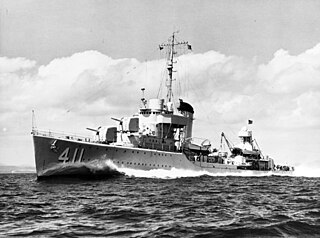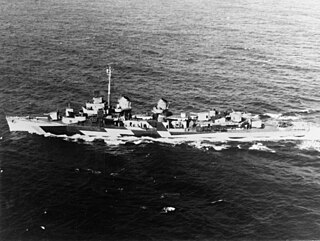
USS Pensacola (CL/CA-24) was a cruiser of the United States Navy that was in service from 1929 to 1945. She was the lead ship of the Pensacola class, which the navy classified from 1931 as heavy cruisers. The third Navy ship to be named after the city of Pensacola, Florida, she was nicknamed the "Grey Ghost" by Tokyo Rose. She received 13 battle stars for her service.

USS Honolulu (CL-48) of the United States Navy was a Brooklyn-class light cruiser active in the Pacific War. Honolulu was launched in 1937 and commissioned in 1938. The ship served in the Battle of Tassafaronga, the Battle of Kula Gulf, the Battle of Kolombangara and the Battle of Peleliu. She was taken out of action by serious torpedo damage just before the Battle of Leyte Gulf. She was repaired, but not in time to rejoin the war. She was decommissioned in 1947 and was held in reserve until she was scrapped in 1959.

USS Kalinin Bay (CVE-68) was a Casablanca-class escort carrier of the United States Navy.

USS San Francisco (CA-38), a New Orleans-class cruiser, was the second ship of three of the United States Navy named after the city of San Francisco, California. Commissioned in 1934, she was one of the most decorated ships of World War II, earning 17 battle stars and the Presidential Unit Citation.

USS Anderson (DD-411) was a Sims-class destroyer in the United States Navy. She was named for Rear Admiral Edwin Alexander Anderson, Jr., a Medal of Honor recipient.

USS Taylor (DD/DDE-468) was a Fletcher-class destroyer of the United States Navy, named for Rear Admiral William Rogers Taylor (1811–1889). She was laid down on 28 August 1941 at Bath, Maine, by the Bath Iron Works Corp.; launched on 7 June 1942, sponsored by Mrs. H. A. Baldridge; and commissioned on 28 August 1942 at the Charlestown Navy Yard near Boston, Mass.

USS Twiggs (DD-591), a Fletcher-class destroyer, was the second ship of the United States Navy to be named for Marine Major Levi Twiggs (1793–1847).

USS Schroeder (DD-501), a Fletcher-class destroyer, was a ship of the United States Navy, named for Rear Admiral Seaton Schroeder (1849–1922). Entering service in 1943, the ship saw action during World War II, participating in the Battle of Tarawa. Following the war the destroyer was placed in reserve, remaining in this state until 1972. She was sold for scrap in 1974.

USS Pecos (AO–65) was laid down 20 April 1942 by the Sun Shipbuilding and Dry Dock Co. as a type T3-SE-A1 tanker, Chester, Pennsylvania, as Corsicana ; launched 17 August acquired by the Navy 29 August 1942; and commissioned 5 October 1942.

USS Kimberly (DD-521) was a Fletcher-class destroyer in service with the United States Navy from 1943 to 1947, then from 1951 to 1954. In 1967, she was transferred to the Republic of China Navy where she served as ROCS An Yang (DD-18/DDG-918) until 1999. The destroyer was sunk as a target in 2003.

USS Young (DD-580), a Fletcher-class destroyer, was the second ship of the United States Navy of that name. She was the first to be named for Rear Admiral Lucien Young (1852–1912).

USS Patterson (DD-392), a Bagley-class destroyer, was the second ship of the United States Navy to be named for Daniel Todd Patterson, an officer of the US Navy who served in the Quasi-War with France, First Barbary War, and the War of 1812.

USS Jarvis (DD-393), was a Bagley-class destroyer and the second of three United States Navy ships to be named after James C. Jarvis, a U.S. Navy midshipman who was killed at the age of 13 during the Quasi-War with France. She saw service in the Pacific during World War II and participated in the invasion of Guadalcanal. The destroyer was sunk to the south of Guadalcanal on 9 August 1942, with all hands - one of only two American major surface warships to be lost in World War II with no survivors.

USS Smith (DD-378) was a Mahan-class destroyer in the United States Navy before and during World War II. She was named for Lieutenant Joseph B. Smith, USN. Smith was a senior officer aboard USS Congress and killed when CSS Virginia sank her.

USS Bryant (The-420) was a Fletcher-class destroyer of the United States Navy, named.,,,,, for, Rear Admiral Samuel W. Bryant (1877–1938).

USS Stack (DD-406) was a Benham-class destroyer in the United States Navy. She was named for Edward Stack.

USS Sterett (DD-407) was a Benham-class destroyer in the United States Navy. She was the second Navy ship named for Andrew Sterett.

USS Terror (CM-5) was a fleet minelayer of the United States Navy, the only minelayer of the fleet built specifically for and retained for minelaying during World War II.

USS Thuban (AKA-19/LKA-19) was an Andromeda-class attack cargo ship in service with the United States Navy from 1943 to 1967. The ship was scrapped in 1984.

The second USS Tisdale (DE-33) was an Evarts-class destroyer escort of the United States Navy during World War II. She was promptly sent off into the Pacific Ocean to protect convoys and other ships from Japanese submarines and fighter aircraft. She performed dangerous work in numerous battle areas, and was awarded four battle stars.




















